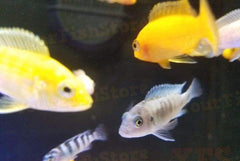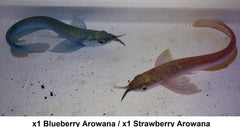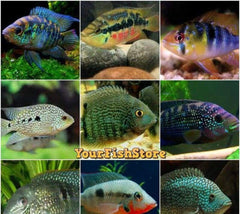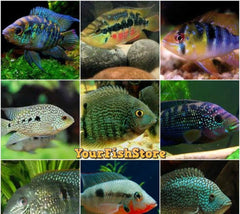Assorted Giant Derasa Clams 6" + (Rare) *Tank Center Piece*

ASSORTED GIANT DERASA CLAMS 6" + - FREE SHIPPING (RARE)
Hand Picked Center Piece Clam
Care Level: Easy
Lighting Requirements: Moderate (PAR 180-300)
Water Flow: Moderate
Aggressiveness: Peaceful
Range: Indo Pacific
Family: Tridacnidae
Water Conditions: 75-80° F; sg 1.024-1.026 (1.025 is ideal); pH 8.1-8.4 Ca 420-440 ppm, Alk 8-9.5 dKH, Mg 1260-1350, Nitrates <10ppm, Phosphates, < .10ppm
Lighting Requirements: Moderate (PAR 180-300)
Water Flow: Moderate
Aggressiveness: Peaceful
Range: Indo Pacific
Family: Tridacnidae
Water Conditions: 75-80° F; sg 1.024-1.026 (1.025 is ideal); pH 8.1-8.4 Ca 420-440 ppm, Alk 8-9.5 dKH, Mg 1260-1350, Nitrates <10ppm, Phosphates, < .10ppm
Benefits to your aquarium
Besides their beauty, clams provide another important benefit to a saltwater aquarium: natural filtration. Their superior filtering capabilities offer added stability and nutrient control in a closed aquarium system.
Excess nutrients lead to problems with low pH, algae, and cyanobacteria blooms - general poor water conditions that ultimately affect the health of all inhabitants within the aquarium.
Clams constantly filter nutrients such as ammonia and nitrate from the water thereby reducing the biological load and lowering the overall nitrate level in the aquarium, improving water conditions.
Environmental Requirements
Clam Lighting
Proper lighting is the most critical parameter essential to the well being of giant clams. Tridacna clams not only filter nutrients from the water to satisfy their dietary needs, but also employ algae cells within their mantle called zooxanthellae. These algae cells require light as well as nutrients from both the clam and the water to properly photosynthesize. The clam then utilizes the energy the algae cells produced through photosynthesis to aid in its growth.
Clams therefore require moderate to high lighting conditions, ideally supplied by reef-compatible LED light fixtures or metal halide fixtures. If using fluorescent fixtures, simply place the clam closer to the light source.
Water Movement
Tridacna clams do not like strong, direct water currents. They prefer moderate, indirect water movement. Strong, direct water movement seems to inhibit the clam's ability to adjust the amount of water passing through it, affecting their ability to properly filter the water.
T. derasa will arrive unattached to any rock or substrate, and prefer to be placed in the sand or in a recess of a rock, as they do not attach as firmly to the substrate or rockwork like most other members of the genus. In the home aquarium, Derasa Clams require moderate to intense lighting to thrive as they contain the symbiotic algae called zooxanthellae, and receive the majority of their nutrition from the light through photosynthesis. Smaller T. derasa that are 2" or less in size are much more sensitive to very intense lighting as their membrane is much thinner than larger specimens.
For this reason care should be taken to properly photo-adapt them to the existing reef aquarium lighting in a similar manner to newly introduced stony and soft corals. When adapting a new Derasa Clam to very intense lighting, it is ideal to set them on a small rock or in a plastic dish with coarse substrate at the bottom of the aquarium. Over time, the clam can then be slowly moved up higher in the aquarium. When maintained in the proper environment, smaller Derasa Clams can double or triple their size in less than a year.
Tridacna clams are also filter feeders and constantly filter the water for small particulates. Derasa Clams larger than 2" do not require supplemental feedings, but smaller T. derasa that are less than 2" should be fed a phytoplankton or greenwater supplement several times per week if maintained in a nutrient poor reef aquarium.
Besides their beauty, clams provide another important benefit to a saltwater aquarium: natural filtration. Their superior filtering capabilities offer added stability and nutrient control in a closed aquarium system.
Excess nutrients lead to problems with low pH, algae, and cyanobacteria blooms - general poor water conditions that ultimately affect the health of all inhabitants within the aquarium.
Clams constantly filter nutrients such as ammonia and nitrate from the water thereby reducing the biological load and lowering the overall nitrate level in the aquarium, improving water conditions.
Environmental Requirements
Clam Lighting
Proper lighting is the most critical parameter essential to the well being of giant clams. Tridacna clams not only filter nutrients from the water to satisfy their dietary needs, but also employ algae cells within their mantle called zooxanthellae. These algae cells require light as well as nutrients from both the clam and the water to properly photosynthesize. The clam then utilizes the energy the algae cells produced through photosynthesis to aid in its growth.
Clams therefore require moderate to high lighting conditions, ideally supplied by reef-compatible LED light fixtures or metal halide fixtures. If using fluorescent fixtures, simply place the clam closer to the light source.
Water Movement
Tridacna clams do not like strong, direct water currents. They prefer moderate, indirect water movement. Strong, direct water movement seems to inhibit the clam's ability to adjust the amount of water passing through it, affecting their ability to properly filter the water.
T. derasa will arrive unattached to any rock or substrate, and prefer to be placed in the sand or in a recess of a rock, as they do not attach as firmly to the substrate or rockwork like most other members of the genus. In the home aquarium, Derasa Clams require moderate to intense lighting to thrive as they contain the symbiotic algae called zooxanthellae, and receive the majority of their nutrition from the light through photosynthesis. Smaller T. derasa that are 2" or less in size are much more sensitive to very intense lighting as their membrane is much thinner than larger specimens.
For this reason care should be taken to properly photo-adapt them to the existing reef aquarium lighting in a similar manner to newly introduced stony and soft corals. When adapting a new Derasa Clam to very intense lighting, it is ideal to set them on a small rock or in a plastic dish with coarse substrate at the bottom of the aquarium. Over time, the clam can then be slowly moved up higher in the aquarium. When maintained in the proper environment, smaller Derasa Clams can double or triple their size in less than a year.
Tridacna clams are also filter feeders and constantly filter the water for small particulates. Derasa Clams larger than 2" do not require supplemental feedings, but smaller T. derasa that are less than 2" should be fed a phytoplankton or greenwater supplement several times per week if maintained in a nutrient poor reef aquarium.
QUESTIONS & ANSWERS
Have a Question?
Be the first to ask a question about this.














